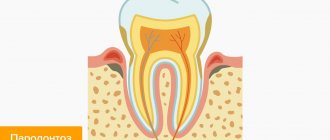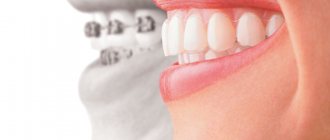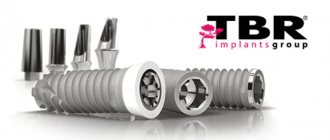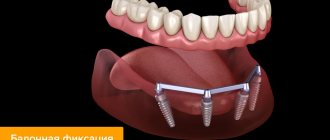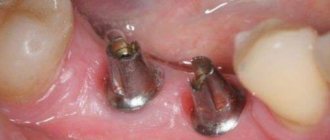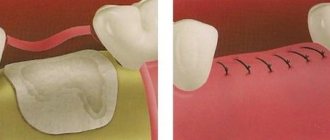Why did I decide to get dental implants?
Implants, artificial tooth roots, prevent jaw bone loss.
And this is not their only advantage. Thanks to them, the oval of the face is not deformed, intelligence is preserved, and it does not drift to the sides when walking. A person gets a chance to chew fully, enjoy a snow-white smile, speak without a speech impediment, and not suffer from health problems. Several years ago, I was sure that crowns and bridges were the only hope to save my dentition. Life showed that this was not the best decision. Grinding down tooth enamel often leads to inflammation of the pulp and always leads to destruction and later removal of the tooth. The crown can last for several years, but the bridge, in the worst cases, does not last even six months.
When I lost several of my lower teeth in this way, it became obvious that I would have to wear uncomfortable and unaesthetic dentures. They turned out to be useless for me (I couldn’t chew, food instantly got stuck under them). They pressed, rubbed, rose during eating, and created painful and uncomfortable sensations in the oral cavity. But their worst drawback turned out to be something else: wearing them resulted in atrophy (loss) of the bone mass of the jaw.
The facial features have changed (the oval has shrunk on the side where the lost teeth were once located), the corners of the lips have drooped, and the nasolabial folds have deepened. So, from my own experience, I was convinced that crowns are a temporary solution to the problem, and dentures (removable or clasp) are no more reliable than dental implants.
The dental materials market offers a huge selection of structures for replacing tooth roots.
To make the right choice in favor of the appropriate type, it is advisable to navigate this diversity and know the main differences between certain implants.
When choosing dental implants, it is important to consider:
- Survivability. If the implant is installed correctly and takes root in the bone tissue, it will last a lifetime. Reliable structures made of titanium. It is important that the alloy contains fewer impurities. Pins made of pure titanium are expensive, but they are highly biocompatible and take root well. In case of an allergy to titanium, zirconium dioxide structures are used for false teeth.
- Durability. Implants that are equipped with a shaped rod hold better. High quality designs feature several types of threads on one implant. Smooth teeth are cheaper, but fixing them is difficult. A high degree of tightness of the connection can be achieved by the conical rod system.
- Aesthetics. An artificial tooth is designed to completely restore the function of a lost one. Therefore, it is important to choose a crown that will match the natural shade of the teeth and repeat their shape. It is also important that the upper part of the implant does not show through the gum.
To do this, it is better to pay attention to models with a reverse narrowing of the coronal part, which, together with the grooves, creates a volume of bone around the implant to support the soft gum tissue.
Thanks to this narrowing and grooves, the artificial tooth looks as natural as possible.
- Availability of a certificate. Dental implantation is a procedure that you would not want to repeat twice. Therefore, when choosing a dental structure, it is not recommended to skimp, because low-quality implants can cause allergies or irritation of the pulp, as a result of which the teeth will simply fall out.
The products of such famous companies as “Mis” and “Alfa Bio” are distinguished not only by their quality, but also by their reliability and manufacturability. These companies are developing innovative technologies, taking into account the characteristics of the physiology and biomechanics of the human body.
- Price. The dental construction market offers implants of economy, middle and premium classes. The latter are considered to be of the highest quality - applicable for the treatment of advanced cases and have a wide range of uses.
Attention! The cheaper the implant, the less its functionality and the higher the risk of possible complications.
Which implants are better to place?
The range of titanium rods is varied. The specialist selects the appropriate option based on the examination results and the anatomy of the patient’s dental system.
Types of structures
They are distinguished by shape:
- lamellar - produced in the form of a plate, designed for installation in a narrow jawbone;
- cone-shaped - root-shaped, used for implantation into bone of sufficient volume;
- combined - represent a combination of plate and cone-shaped implants, indicated for jaw atrophy.
At the place of implantation:
- endosseous - involve intraosseous installation;
- subperiosteal - installed in the subperiosteal area (between the jaw bone and the periosteum);
- intramucosal - implanted into the mucous membrane to fix prostheses or orthodontic structures.
Endosseous and subperiosteal structures
Criterias of choice
- Biocompatibility of materials - implants made of pure titanium or its alloys, zirconium dioxide, and ceramics have proven themselves well.
- Surface treatment - the process of osseointegration will be faster and more successful if the implant has a porous, rough surface. Classic processing consists of sandblasting with titanium oxide followed by acid etching.
- Surface coating - some models have a special coating that stimulates regenerative processes.
- Product dimensions - length can be 6-16 mm, diameter - 3-6 mm.
- Threading - for dense bones, it is unacceptable to use models with too aggressive threading. Implants with self-tapping threads are installed on moderately dense bone.
- Type of connection between the crown and the implant - there are several types of abutments: standard, multi-component, spherical with cement and screw fixation.
- Service life is on average 15-30 years.
- Official guarantee, quality certificate.
Which manufacturer should you prefer?
A brief overview of the advantages of popular systems:
- Swiss Roots have a one-piece structure, which allows for minimally invasive single-phase implantation with immediate loading.
- Swiss Nobel Biocare are premium systems. They have a patented TiUnite surface treatment technology, which promotes rapid healing.
- German Ankylos have a special Fiadent Plus coating and extra space on the neck to protect soft tissue.
- German XIVE are made of pure titanium, have a combined thread and a patented coating.
- South Korean Osstem are sandblasted with aluminum oxide, acid etched, and enriched with calcium for better osseointegration.
- Swedish Astra Tech have a unique OsseoSpeed coating and a special Microthread thread, which ensures reliable adhesion of the crown to the prosthesis.
- Israeli Alpha Bio ensure a tight gingival fit and good initial stability.
Photo after restoration of the dentition using implants
Large molars enable food processing. In their absence, rough food can cause inflammation of the gastric mucosa (gastritis). Also, gradual loss of bone tissue can further complicate implantation.
Removal of 1-2 teeth often leads to disruption of the growth of the remaining teeth, striving to take up the vacant space. And the loss of molars also changes the contours of the face - the cheeks may sink inwards, wrinkles appear, and this does not look very aesthetically pleasing, especially with one-sided defects.
Dentistry can offer patients with such problems removable prosthetics and implantation. Implantation has a number of obvious advantages.
New job, Kirill 55 years old.
Possible options for installing implants
The choice of method depends on the number of missing teeth and the condition of the patient's jaw bone.
- In the absence of 1-2 teeth.
Implantation of chewing teeth is carried out according to the classical protocol. The doctor first installs the implants, then waits 2-4 months for them to fuse with the bone tissue. As a rule, systems take root faster on the lower jaw than on the upper jaw, since the bone here is denser. At the end of the engraftment period, a temporary prosthesis is installed on the implants, and after another month - a permanent one. The peculiarity of classical implantation is that it requires the patient to have a sufficient amount of bone tissue. But with the absence of teeth for a long time, most people experience bone atrophy (thinning). Therefore, before implanting molars, it is necessary to carry out additional intervention - bone grafting. - In the absence of 3 or more teeth.
Basal implantation is optimal. The advantage of this technique is that it does not require preliminary bone augmentation and allows the installation of implants along with the prosthesis in just 2-4 days. Unlike classical ones, basal implants are fixed not in the superficial, but in the deepest layers of the jaw, which do not decrease over time. The lower layers are harder and stronger, so the systems are securely held in them and do not loosen under load. After 2-4 days, after the soft tissues have healed, the implants are covered with a prosthesis. The design is non-removable and fully functional. Almost immediately, patients can chew moderately solid food, and after a week they return to their usual diet. The only disadvantage of basal implantation of molars: it is not applicable to patients with 1-3 missing teeth in a row. The fact is that basal implants are fixed at an angle and in the limited volume of bone there may simply not be enough space for them.
In what cases is the installation of implants rejected?
Implantation has many advantages and only one disadvantage. It is not available to everyone. For this reason, at the first consultation, the specialist writes out a referral for a blood test, does a thorough examination of the oral cavity and asks questions about the patient’s chronic diseases.
What diseases are contraindications:
- Diseases of the blood, heart, blood vessels, connective tissue, liver;
- Pathologies of the thyroid gland;
- Oncological processes;
- Mental disorders;
- Allergy to medications;
- Inflammation in the oral cavity;
- Poor hygiene as a habit;
- Taking medications - bisphosphonates (they affect the structure of bone tissue).
For all other patients, free from contraindications, implants are not only possible, but necessary (and no later than three months after tooth extraction). If you miss this time, you will have to do an additional sinus lift (bone tissue augmentation using your own or donor material).
When is bone grafting needed?
This term refers to osteoplastic surgery. Their goal is to replace bone tissue lost as a result of atrophy with a biocompatible material . After tooth extraction, the jaw area ceases to experience chewing load. The vessels die and stop feeding the bone. This leads to its resorption (resorption), which makes the jaw tissue loose. Already 3-6 months after removal, atrophy begins if the patient does not have an implant installed. Only implantation can stop atrophy. Under removable dentures, bone resorption continues because there is no proper load on the bone.
The decision to perform osteoplasty is made by the doctor based on the clinical picture, as well as the chosen technique for implanting the titanium root. They resort to extension:
- With thinning and changes in bone density;
- In case of congenital bone deficiency or other anatomical features;
- In case of injuries to the dentofacial apparatus in the area where a titanium support is installed.
With classical implantation, sufficient bone volume is a prerequisite . Therefore, if there is a deficiency, preliminary tissue extension is carried out in a separate stage. It takes up to six months for the planted material to take root.
With one-stage implantation, due to the special shape of the implants, implantation can be carried out in conditions of moderate bone tissue atrophy. If it is not enough, osteoplasty is combined with the introduction of a titanium support. If there is practically no bone tissue, the operation is performed at the preparatory stage.
Osteoplasty in the area of chewing teeth is different:
In the lower jaw, surgery is necessary when the height or width of the alveolar process decreases, when the distance to the mandibular canal decreases. The methods used are directed bone regeneration, bone block grafting, and alveolar ridge splitting.
Bone grafting of the upper jaw is otherwise called sinus lift. The sinuses are called the maxillary sinuses. The purpose of the surgical intervention is to lift their lower part. The space is filled with osteoplastic material. The operation is performed before or in conjunction with implantation. Sinus lifting is performed using open and closed methods:
- For simultaneous implantation, a closed technique is used;
- After an open sinus lift, the implant is placed after 4-7 months, when the wound has healed.
Installation of dental implants: briefly about the main thing
Implantation is a long process. For several months you have to visit the surgeon:
- take a blood test;
- take a panoramic photo and record it on disk;
- drink antibiotics and Linex;
- look at your distorted, swollen face with a hematoma for several days;
- endure pain and obey food prohibitions.
Installation of an implant includes several stages common to all, but they are all completed individually. The sensations and impressions are different, but the result is the same: the artificial tooth looks like your own and is no different from natural ones. It is reliable, aesthetic, and not susceptible to caries.
For the sake of such beauty it is worth spending money, time and a little of your nerves. Local anesthesia allows you to go through all stages without noticeable pain. If only when screwing in the implant the bone hurts a little, and when drilling you feel a slight vibration.
After 10 days, the stitches are removed. After three months, a gum former is installed, which is removed after a few days, and then impressions are made and a crown is installed. This is the final stage and it takes place in the office of a specialist - an orthopedist. Here everything happens the same as with conventional prosthetics. You can't get away with just one visit.
Many patients say that in the first days or weeks (depending on luck) there is a sensation of a foreign body. For this reason, there is no great excitement after implantation. Joyful feelings come a little later. Therefore, if you start reading the reviews of those who have just acquired an implanted prosthesis, you may get the wrong idea.
The province, not Moscow. There is not a large selection of implants. At the first consultation, the specialist usually offers the ones they currently have. For this reason, it is unlikely that anyone will dare to ask questions about the brand of material, surface structure, shape, size and type of thread of the implant. Although such information can be useful in all other cases (when there is a large choice).
Which implants are really better:
- Made of titanium, the grade of which is not lower than grade 5;
- With micro-relief of the surface, repeating the structure of natural bone;
- A size that matches the size of the bone area selected for implantation;
- European and American manufacturer.
- With conical shape or patented platform switching system.
- With several types of thread (for hard and soft jaw bone).
- With three-channel connection type.
Choose a reliable dental clinic with a good reputation for implantation, equipped with a digital orthopantomograph or computed tomograph and a highly qualified specialist, then you will not have to ask questions that you do not understand during the consultation. Look online for reviews from real people who have used the services of the clinic you have chosen.
At one time I was offered to get Astra Tech implants (Sweden) with a high-quality OsseoSpeed TX system. I paid 84,000 rubles for two artificial roots. They selected sizes for me that perfectly matched the size of the bone area chosen for implantation. Implants from the manufacturer Astra Tech have many options for pin diameters and lengths.
Also, high-quality implants have the names Nobe Biocare (40,000 - 70,000 rubles per pin), Straumann (40,000 - 50,000 rubles), Ankylos (20,000 - 30,000 rubles), Schutz, Zimmer (18,000 - 30,000 rubles ), Niko (23,000 - 28,000 rubles).
Budget implants that cost 7,000 - 17,000 rubles have one significant flaw. You will not be able to fully chew on such teeth. They are not durable, like American or European ones (their quality is so poor that such implants do not last long).
Despite the 5% failure rate of operations, implantation is becoming more popular every year than traditional prosthetics. Analyzing patient reviews, we came to the conclusion: a dental implant is better and more reliable for life than a bridge or prosthesis.
Only with them, and also with veneers, can we achieve that Hollywood smile with dazzling snow-white teeth that we all dream of. There are simply no other ways. And this is one of the significant arguments in favor of implantation rather than prosthetics.
So, let's compare the pros and cons of dental implants to make sure you're making the right choice.
Advantages of high-quality implants:
- Durable (30 years);
- Provide a high quality of life;
- They are installed autonomously, without grinding down adjacent healthy teeth;
- Aesthetic (they also help create a Hollywood smile);
- Easy to care for (like healthy natural teeth);
- Keep taste buds “working”;
- When there are not many teeth in the oral cavity, only implants can help (not dentures, which bring additional problems and discomfort).
Cons of implantation:
- You have to endure fears, worries before surgery and pain, discomfort, cosmetic defects of the face - during a short rehabilitation period;
- Load on the body (taking antibiotics and other medications);
- Contraindications for certain categories of people;
- Big waste of money.
Having studied the reviews of patients who had implants installed, I can safely say: there are no other pros and cons. With good hygiene, they have an unlimited service life. Dead teeth under crowns or bridges are destroyed within a short time. By the age of 50, a person is left without complete dentition (at best) and with dentures in a glass on a shelf (at worst).
What choice to make is up to you. From my personal experience, I know for sure that it is better to get dental implants.
Types and design of implants
There are many different types of dental implants: root-shaped, lamellar, subperiosteal, combined, etc. However, the most popular are root-shaped implants, which are very popular among doctors and patients all over the world. They are usually made from titanium, zirconium dioxide and other biocompatible materials.
Typically, root-shaped implants consist of an intraosseous part and a supragingival suprastructure - an abutment, which serves as a direct support for the orthopedic structure. The intraosseous part is a rod that replaces the root of a lost tooth. The abutment is attached to it using a secure screw connection.
Jaw bone augmentation, review
Building up the jaw bone for a dental implant is called a sinus lift. This operation is necessary only in exceptional cases when bone tissue atrophy has occurred. 70% of people face this problem.
Bone changes in the jaw begin after tooth extraction. After a few months, without sinus lifting, implant installation becomes impossible.
So, the causes of atrophy: lost teeth over a long period of time, bridges and removable dentures. I went through all these failures of classical prosthetics and I regret that I did not get implants earlier. I could do without sinus lifting. And he left terrible memories in my memory.
The beginning of this story did not bode well. Three days before the operation, I started taking antibiotics, which severely undermined the gastrointestinal tract. Dysbacteriosis was evident.
As it turned out later, you need to take Linex along with antibiotics. Next was surgery with local anesthesia. She passed without the slightest discomfort or pain.
What are your memories and impressions?
- The first days I could not eat fully (only cereals, fruits and no solid food);
- Half of the face was swollen and blue from a hematoma;
- The lips were also partially blue, and their sensitivity did not recover for several months. By the way, the edge of the lower lip remained frozen. The doctor said that this problem will pass someday too.
- A month later the blue color changed to yellow. At work I sat with a scarf tied around my head. My appearance was such that it would be better if I was on vacation and sat at home or decided to do a sinus lift on Halloween. I would get all the prizes.
Fortunately, time is a healer and after 4 months my bone mass has increased.
• take care of your teeth (use high-quality toothpaste, brush, irrigator); • do not install crowns or bridges (this idea always ends in the loss of teeth); • after removing the roots, do not delay, run to install an implant (it will be cheaper and without complications), • agree to donor material, then the operation will be performed using only local anesthesia.
Jaw bone augmentation can be performed using the patient's own bone mass. But such an operation takes place under general anesthesia.
The price of dentures on implants is individual for each particular case. It consists of the cost of the abutment (which is screwed into the implant) and the crown (metal-ceramic or all-ceramic zirconium).
For example, turnkey prosthetics with the installation of one implant costs 32,000 - 42,000 (a budget option, which is not recommended), Root Form or Nebel 56,000 - 70,000 rubles. The first number refers to metal-ceramics, and the second to the zirconium dioxide crown.
Prosthetics with the production of a conditionally removable acrylic prosthesis for 4 implants costs 130,000 rubles. If you need a fixed prosthesis (horseshoe-shaped), which is fixed on 10 implants, then you will have to prepare about 280,000 rubles.
At first glance, it may seem that implant-supported dentures are expensive, but in reality the costs are lower than litigation with old-fashioned dentures. In the first case, you paid a lot of money and live without worries with good hygiene. The second case is tragic (several times in your life you spend money on crowns, bridges, dental treatment, and as a result, at 50 you are left without teeth).
Dentures on high-quality implants are no different from natural teeth. All functions are preserved 100%. You can also chew, bite, and taste food.
Types of dentures on implants:
- removable with a latch (installed on 2 implants);
- removable with support on a beam structure;
- fixed crowns and bridges.
I placed a crown made of metal and plastic on the front tooth. The appearance is no different from natural teeth. I bite and chew solid food. For 7 years nothing has broken off and the color has been preserved. Although the reputation of such crowns is not ideal and the service life is only 5 years, nevertheless, I have nothing to complain about.
Crowns made of zirconium dioxide or aluminum are considered the best. They last 20 years without changes under any load. Positive reviews are mainly left by those who have installed permanent crowns and bridges. And their service life is longer than removable ones. The price is higher, but commensurate with the quality.
Method of implantation of chewing teeth
In the process of eating, chewing teeth are subject to the greatest load, and this characteristic feature must be taken into account during implantation. Therefore, to restore teeth in this area, they usually resort to the classical implantation technique, which is carried out in several stages. First, an operation is performed to install implants in the jaw bone tissue.
A fairly long waiting period is then required for their complete osseointegration, which lasts about 4–6 months. After this, abutments are installed and a prosthetic structure is made, which is then fixed in the patient’s mouth. The use of the classical technique ensures excellent resistance of implants to stress and a long service life.
Implantation of lateral teeth
When implanting chewing teeth, any dental implantation method can be used - it all depends on the indications, the condition of the bone tissue, and the number of missing teeth. After a visual examination and diagnostic procedures, doctors will offer several options for solving the problem, talk about all the advantages and disadvantages of each, so the patient will have a choice - which method to prefer:
- one-stage implantation with immediate loading: this is the main method that is recommended in the absence of 3 or more lateral chewing teeth. As a rule, when wearing a removable denture or dental bridge for a long time, bone tissue atrophy continues under the structure – i.e. it is significantly reduced in volume. One-stage implantation allows the installation of implants without an extension procedure - the structures are fixed in the deep parts of the jaw bone, which are not subject to atrophic processes. Important addition: this protocol is relevant only if 3 or more teeth are missing. After all, a certain place for implants is required. In addition, since the prosthesis is attached immediately, it must stabilize the installed implants and prevent them from moving under chewing load - and this is only possible with a sufficient number of supports,
- single-stage implantation: a method that involves removing teeth or tooth roots and simultaneously replacing them with implants. It is carried out in cases of planned removal, since implantation requires certain preparation,
- two-stage implantation with delayed loading: recommended for cases of tooth restoration with sufficient bone tissue, as well as for single restorations. During the healing period of the implants, this protocol uses removable immediate dentures, which restore the aesthetics and functionality of the dentition. But, naturally, the load on them should be limited.
Veronica Viktorovna
“I had my teeth done 1.5 years ago. There was a gag reflex from wearing a removable denture on chewing teeth. As a result, I transferred all the load to the front ones, which became mobile and ugly. I couldn’t eat normally and was embarrassed to smile. As a result, my husband found this clinic. After 4 days I was home with a beautiful snow-white smile. And if they tell you that this is impossible, do not believe it! It’s possible, look at me!”
“After implantation, I can eat WITHOUT pain - it’s incredible!”
watch a video with the patient
Selection of implantation method depending on the problem
One lateral tooth is missing
If a tooth is missing along with the root and was removed some time ago as a result of some advanced dental disease, the recommended solution is a two-stage implantation. In case of subsidence and atrophy of bone tissue, before the implantation of a two-component implant, a augmentation procedure will be performed to increase the volume of the bone. While the implant is healing, a removable immediate prosthesis is fixed.
What patients say about treatment
Anna Vladimirovna After dental implantation using the Nobel Biocare brand
Elena Vladimirovna Our doctors choose their own colleagues!
Elena Borisovna After installing Straumann implants to replace part of the teeth
Nadezhda Mikhailovna After single Straumann implantation
— After dental implantation using the Nobel Biocare brand
With the attending physician, implant surgeon Alexander Vasilyev, after the operation to install a single Nobel Biocare implant. Ahead is prosthetics after complete fusion of the implant with the tissues of the jaw bone.
Anna Vladimirovna
After dental implantation using the Nobel Biocare brand
Doctor: Specialization: Experience:
from 3 months
View all reviews
— Our doctors choose their own colleagues!
Dentist-therapist Elena Orlova with implant surgeon Alexander Vasiliev - after dental implantation: Elena Vladimirovna had Straumann brand implants installed. Ahead - prosthetics!
Elena Vladimirovna
Our doctors choose their own colleagues!
Doctor: Specialization: Experience:
from 2 weeks
View all reviews
— After installing Straumann implants to replace part of the teeth
With the attending physician - dentist-implantologist Alexander Vasiliev - after installing single implants of the Swiss premium brand Straumann according to a two-stage implantation protocol with delayed loading. Ahead is the implantation of implants and installation of single crowns.
Elena Borisovna
After installing Straumann implants to replace part of the teeth
Doctor: Specialization: Experience:
from 2 weeks
View all reviews
— After single Straumann implantation
With the attending doctors - implantologist Alexander Vasilyev and orthopedist Andrey Chernov - after performing a single dental implantation using the Straumann brand with delayed loading.
Nadezhda Mikhailovna
After single Straumann implantation
Doctor: Specialization: Experience:
from 2 weeks
View all reviews
A segment of chewing teeth is missing
In the absence of 3 or more teeth in a row, it is possible to use both two-stage and one-stage implantation. However, the second option is more preferable - chewing function can be fully restored in 2-3 days by fixing a fixed prosthesis with an acrylic base - artificial gum - on installed implants. In this case, bone grafting is usually not required, since the implants are attached to deep and strong parts of the bone structure (or the bone is replanted at the same time).
Missing teeth on both sides of the row
In this situation, the shape of the remaining front teeth must be assessed. If they are in poor or rotten condition, the best option would be to remove them and immediately replace them with implants. At the same time, several more solid implants are installed in the lateral zone, and after 2-3 days a fixed prosthesis is fixed.
Expert opinion
Kopylov Ivan Pavlovich Oral and maxillofacial surgeon, implantologist Work experience 14+
“If three or more lateral teeth are missing, a one-stage implantation technique is used, which instantly restores the functionality of the dentition. This protocol allows you to achieve the main goal - the ability to eat well. True, the load on new ones will have to be increased gradually.”
Loose or diseased teeth
If there are teeth to be removed, it is recommended to carry out one-stage implantation, when the implant is fixed into the socket of a newly extracted tooth - two operations are carried out simultaneously. If teeth are removed urgently, and the space in the row does not allow the installation of implants nearby, then you will have to wait for bone regeneration - this should take 2-4 months, after which it will be possible to install implants in a one-stage or two-stage method.
Disadvantages of dental implantation
In the absence of a segment of chewing teeth, it is possible to carry out a one-stage implantation with the immediate installation of a prosthesis, which can be used to completely chew food almost immediately. Therefore, the issue of aesthetics and functionality is removed. On the other hand, implantation is not possible in all patients: failure may occur due to health conditions. In addition, the technique requires surgical intervention and, naturally, the price of prosthetics is much higher than installing, for example, removable structures. And these are the main disadvantages of the approach.
Patient history
“My chewing tooth on the left side collapsed and it was not possible to save it. At the clinic, on the third day, it was aesthetically restored to me, and I was able to chew fully within a month. Everything went without complications or inconveniences. Thank you very much for your high professionalism, sensitivity and attention!”
watch a video with the patient
What does the doctor take into account when choosing an implantation method?
It is impossible to answer this question unequivocally, since they all have their own characteristics and can differ significantly in cost. Much depends on the manufacturing company and manufacturing technology. Products from Nobel Biocare, Straumann and Astra Tech are very popular among doctors and patients, although the cost of these implants is quite high.
Implants from MIS (Medical Implant System), Alpha-Bio and Dentium have also proven themselves to be excellent, and are affordable for a larger number of patients. In any case, the choice of implants must be made together with a qualified dentist, who will help you choose the most optimal option for a specific clinical situation and the patient’s capabilities.
- number and location of lost teeth;
- the presence of bone atrophy at the intended installation site;
- the quality of the bone tissue itself (the absence of foci of osteoporosis, excessive friability that interfere with primary stabilization).
Taking into account the patient’s wishes, the dentist at our AcademStom clinic will select the appropriate technique and perform implantation.
Which dental implants are better: popular rating
There are no perfect dental implants. By studying patient reviews, we have compiled a rating of the most popular manufacturers. People believe that the most reliable are German and Swiss implants.
Among the trusted manufacturers:
- Nobel Biocare, Straumann (Switzerland);
- Astra Tech (Sweden);
- Ankylos, Xive Friadent (Germany).
Among manufacturers of budget implants, the following are very popular:
- MIS, Alpha Bio, Ards (Israel);
- Implantium (Korea).
Low prices, but high quality products.
Nobel Biocare has a high implant survival rate, but Astra Tech is still one of the best in all respects (enough for 30).
Usually only experienced doctors work with German implants, and this is an additional plus.
The conclusion is obvious: it is better to pay more, but be sure of the quality, and therefore of your future. Although many people installed inexpensive analogues (Belarusian, Russian) and do not regret it. Reviews for these implants are also good, they take root well, and there are no side effects. However, we must admit that the service life of such cheap analogues is short.
Review written by: Natalya Sh.
Implantation of chewing teeth at the ARTOX clinic
- There is no need to injure healthy teeth by using them as a support for a prosthesis.
- It is possible to restore 100% tooth function. The implant is made of durable titanium and can withstand chewing loads.
- There is no atrophy, since the load on the bone is the same as from your own teeth.
- Normal bite and growth of adjacent teeth. Maintaining normal diction.
- Convenience of prosthetics. According to the subjective feelings of most patients, a new tooth supported by an implant is no different from others.
- Long service life. This type of prosthetics can serve a person for decades. Good stabilization of the implant and high-quality materials are the key to this.
ARTOX Clinic offers installation of implants from leading global manufacturers at affordable prices. The high professionalism and extensive experience of our doctors will help you effectively solve the problem of missing chewing teeth and enjoy a full life.
Materials from which artificial teeth are made
Titanium is most often used to make dental implants. However, there are situations when the body rejects this metal.
In such cases, implants made from:
- made of gold;
- glassy carbon;
- corundum ceramics;
- titanium nickelide.
Metal ceramics are low cost. Such dental crowns are aesthetic and reliable. The low price is due to fastening using a metal abutment.
Zirconium is a lightweight modern metal that is widely used in dentistry. Crowns made from this material have excellent external characteristics and high strength.
Materials exhibit their best properties provided that the installation location is chosen correctly. If you need to restore chewing teeth that are subject to increased stress, it is better to give preference to zirconium crowns. And for the restoration of the front part of the dentition, metal ceramics are suitable.
Stages of installing implants on chewing teeth
Diagnostics
At this step, a visual examination of the oral cavity is carried out, and diagnostics are also performed using modern scanners, which allow a detailed study of the condition of the patient’s jaw. A mandatory point is to conduct laboratory examinations, which eliminates any restrictions for implantation of chewing teeth in the upper jaw or in the mandibular region.
Preparatory procedures
Before surgical intervention, the specialist carries out therapeutic measures aimed at eliminating carious lesions and removing hard deposits on the surface of the teeth.
Implant fixation
To numb the site of future intervention, local anesthetics are used. As part of the traditional procedure, the dental implant is fixed in a straight position; when implementing a one-stage technique, an inclined installation of the structure is allowed. In the case of a two-stage concept, a special plug is used and the gums are sutured. When using a one-piece implant, the adapter is already included in the design and is located above the line of gingival tissue.
Abutment installation
Fixation of the connecting element is carried out exclusively after osseointegration of the classical type implant (after 16-24 weeks). 14 days before this moment, the structure is installed to create the correct gingival contour.
Fixing the crown on the implant
Taking into account the technique used, the installation of the orthopedic structure is carried out immediately or after completion of the engraftment stage. In the case of one-stage technology, fixation of prostheses is allowed 48 hours after surgery. In the traditional procedure, only after the end of the osseointegration period.
Length
The length of the rod is determined depending on the thickness and density of the bone tissue at the installation site. For thin bones, short models are used.
If enhanced fixation is required (for example, to restore a chewing tooth), dental implants with a larger diameter are used.
If a structure with teeth is installed in narrow interdental spaces (for example, in the case of restoration of anterior teeth), then a smaller diameter will be required.
The minimum length and width of dental implants is 1.8x0.5 mm. Most often, the length of the pin does not exceed 17 mm.
How to determine it?
The specialist selects the necessary rod parameters based on individual indications. In order for a dental implant to reliably integrate into the bone tissue, it is important for the doctor to know:
- bone mass and size;
- structural features of the patient's jaw;
- the distance between adjacent teeth.
Important! The length of a dental implant is not an indicator of its quality. The main thing when determining this parameter is the installation location, since its engraftment depends on how well the rod matches the size of the sinus.
An alternative to implants in dentistry for chewing teeth
Other alternative techniques may also be used, including:
- Application of a bridge structure. In this case, the role of supports is played by the patient’s natural teeth, located on the sides of the prosthesis. However, fixation of the bridge is allowed only after preparation of the supporting units and removal of the pulp, which is one of the significant “disadvantages” of the procedure. Another negative point is the lack of sufficient load, which causes bone tissue atrophy. This design is used to replace 3-4 teeth located in a row;
- Use of a removable prosthesis. Depending on the extent of the defect, the appropriate method of tooth restoration and material are selected. If only a few units are missing, special hooks are used as fastening. In the case of an absolute lack of teeth, a suction effect is realized. The “disadvantages” include: the need for regular removal of the structure, deterioration of the speech apparatus, further resorption of bone tissue and the appearance of serious aesthetic problems.
Article expert (author):
Leading countries in production
Technological and high-quality implants are manufactured in Switzerland. Nobel Biocare and Staumann take first place in the world, as these implants take root with a 99% probability.
Photo 1. Three titanium dental implants from the American company Bicon are highly technologically advanced.
Next come the following countries and brands:
- America (Bicon, Denstply).
- Germany (Ankylos, Xive).
- South Korea (Osstem, Implantium).
- Israel (MIS, Alpha Bio).
The structures made in Switzerland, America and Germany are of high quality, but expensive. Together with installation, the price reaches an average of 100 thousand rubles, and this is only for one tooth. Korean and Israeli brands offer models from an affordable price segment that are not inferior in quality to the leaders in the dental market.
Israeli companies have been operating for more than 30 years, so they have already proven their quality. With proper care, implants from Israel can last a lifetime.
In South Korea, they started manufacturing dental structures only recently, but Korean specialists have already learned to use modern technologies and even introduce their own developments. In a relatively short period of time, Korean brands managed to reach the same level as Alpha Bio, which indicates confident development and shows a decent level of quality.
Photo 2. Eight implants of different lengths from the Korean company Alpha Bio are of high quality.
Producing countries - which are the best?
The price range is divided into 3 categories - premium, medium, economy. Categories are distributed by country and manufacturer. Prices for implants of different brands within the country are approximately the same, since manufacturers compete within the same state and try to be competitive in price and quality.
Manufacturing countries of implantation systems by price category:
- Premium - Switzerland, USA, Sweden, Germany.
- Middle - South Korea, Israel.
- Economy - Russia, Belarus.
Just a few decades ago, there were only a couple of manufacturers of titanium rods in the world that imitate tooth roots, and the implantation procedure itself was carried out only in Western European countries.
Today it is an advanced technology for dental restoration, which is used by dentists everywhere. Due to such popularity of implantation, the number of companies producing dental implants has increased significantly.
Few people understand how the products differ from each other and how prices for implants are determined.
By the 2000s, the manufacturing countries that occupied leading positions in the production of implants had been identified: the USA, Switzerland, Germany, Israel and Korea. Large companies are concentrated there, producing about 90% of dental structures from the total market share.
Products vary widely in price and other features, but which implants are considered the best? There is no clear answer to this question: recommendations vary for different clinical cases.
We present to your attention a rating of dental implants by manufacturer and descending price with a description of the pros and cons that will allow you to make your choice.
Swiss dental implants.
Everything that is produced in Switzerland a priori indicates premium quality, and implants are no exception. The most popular, reliable, but expensive brands of implants are made here.
Straumann and Nobel Biocare systems are distinguished by the best survival rate (99% or more), functionality, flawless imitation of natural teeth and are used in complex clinical cases.
The luminaries of implantology prefer to work with these brands.
A significant disadvantage of Swiss implants is their high price: a titanium rod alone will cost about 1,900 BYN. But in the long term, this option turns out to be economically feasible, since implants are installed once and virtually for life.
American dental implants.
Dentists are familiar with such brands as Bicon, Biohorizont, Denstply. The Dentsply brand is a huge holding company that specialized in the sale of dental equipment, but in time saw the benefits of investing in the implantology industry.
In order not to invest in technology development, the company bought several European brands: Xive (Germany), Astra Tech (Sweden), etc. All these companies produce implants under their own brands, but are owned by Dentsply.
American dental implants are distinguished by their rapid survival rate, operational reliability and aesthetics. Installation cost – from 1200 BYN.
German dental implants.
German companies are among the leading manufacturers of dental implants. Germany was not at the origins of implantology and began activity in the 80s, using world experience and its own developments. This position of the manufacturers contributed to the merger with well-known American companies.
Today, German brands are represented by the trademarks Xive, Ankylos, SHUTZ, Impro, NDI Medical. The presented orthopedic solutions are on par with the top segment, they are distinguished by their reliability and impeccable aesthetic characteristics.
The meticulousness of the Germans is also evident in the production of implants: their systems are highly valued all over the world.
The cost of German systems is on par with American ones.
High quality, a wide range of models and good survival rate ensure sufficient popularity of Korean implants in the market of post-Soviet countries.
Leading experts claim that Korean systems are not inferior to top-end ones in terms of aesthetic results and are available to patients with different incomes, including low incomes: they cost from 660 BYN.
Israeli dental implants.
Implantation systems from Israel occupy a budget niche, but are deservedly called one of the most reliable and durable.
Israeli implants Alpha Bio, ADIN and MIS are quite popular in Belarus: they can solve the problem of missing teeth in various cases, are easy to use and have a long service life.
A small drawback that clinicians often talk about: the lack of expanded opportunities at work.
In the Russian Federation, systems for implantation have been successfully produced for a long time. The most popular brand is IRIS: it is a modernized LIKO-M system, which began production about 20 years ago. Implants are made from GRADE-4 titanium in Italy using domestic technology that complies with ISO 9001-2000 (international standard).
First of all, the manufacturer’s brand is associated with the cost of the implant: prices for well-known brands are always higher. This is due not only to the name, but also to the fact that companies invest enormous amounts of money in innovation and development.
A high price also means greater opportunities for the patient and the doctor, who does not have to choose between functionality and aesthetics.
Orthopedic structures can help in difficult situations and guarantee a beautiful smile even in the absence of teeth. However, this does not mean that dental systems in the economy category are of poor quality.
Quite the contrary - it is a worthy alternative to expensive analogues.
We invite you to familiarize yourself with Preferential dental prosthetics in 2020: who is eligible, how to do it, laws and the latest news

